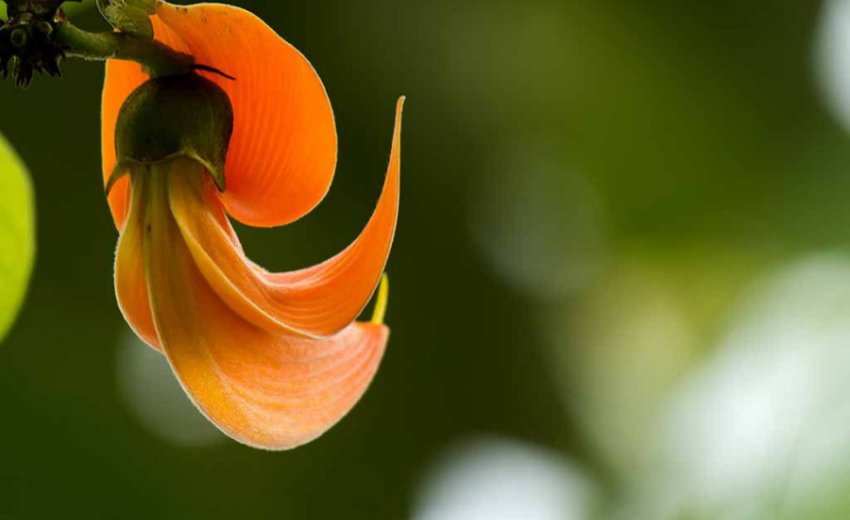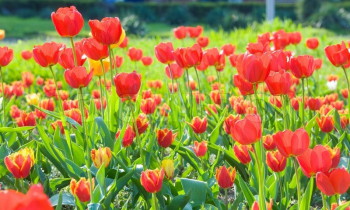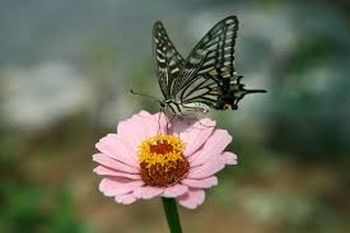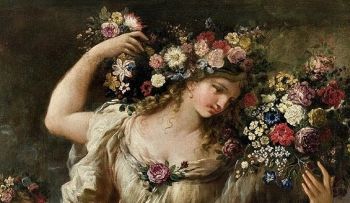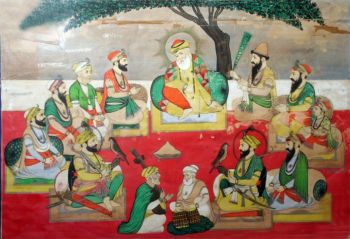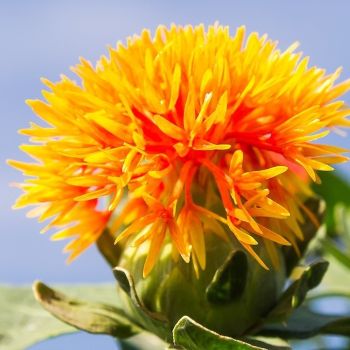FLOWERS – A PERSPECTIVE FROM SRI GURU GRANTH SAHIB
Dr. Devinder Pal Singh
Flowers are the marvels of beauty. They add a myriad of colors to our environment. People throughout various cultures and lands have been drawn to their beauty and fragrance.
Since ancient times, flowers have been used for adornment and to express intimate feelings. Apart from the color, fragrance, beauty of form and texture of a flower, there is something more - an aspiration, an emanation, an aspect, a psychic giving, wordless prayers of nature and progress in the evolution of the earth1-3. Flowers have amazing diversity. There are estimated to be over 270,000 different species of flowers around the world. The plant fossils dating back 146 million years have been found. A myriad of images of preserved flowers and their parts have been found in fossils located in Sweden, Portugal, England, and along the Eastern and Gulf coasts of the United States4.
Flowers – Exquisite Beauty and Fragrance
Sitting pretty on the heavy buns on women's heads may be the best decorative use of flowers, but not the only one. Water or oil added with floral fragrances serve as ingredients in food items or medicinal treatment. Floral offerings are common to almost all religious celebrations. In polytheistic Hinduism, there are even specific flowers for various gods and goddesses: lotus for Lakshmi, red hibiscus for Kali, dhatura for Shiva, etc. Thus, from the earliest days of Eastern civilizations, flowers have held a special position.
Appreciating the innate marvelous characteristics of flowers, Guru Arjan Dev, the fifth Sikh Guru, expressed that the whole world is like a wonderful garden, full of scent, color and beauty5-6.
ਨਾਨਕ ਫੁਲਾ ਸੰਦੀ ਵਾੜਿ ਖਿੜਿਆ ਹਭੁ ਸੰਸਾਰੁ ਜਿਉ ॥ (ਮ. 5, ਪੰਨਾ 1095)
Nanak, the entire world is blooming, like a garden of flowers. (Mehl 5, SGGS, p 1095)
Creation of Flowers
A flower contains all the elements of nature - air, water, fire, earth, and ether. In Sikhism, nature with all its worldly phenomena is considered as the manifestation of God. According to Guru Nanak, the first Sikh Guru, God is the creator of all things and beings and He resides in His creation.
ਆਪੀਨ੍ਹ੍ਹੈ ਆਪੁ ਸਾਜਿਓ ਆਪੀਨ੍ਹ੍ਹੈ ਰਚਿਓ ਨਾਉ ॥
ਦੁਯੀ ਕੁਦਰਤਿ ਸਾਜੀਐ ਕਰਿ ਆਸਣੁ ਡਿਠੋ ਚਾਉ ॥ (ਮਹਲਾ 1, ਪੰਨਾ 463)
He created Himself, and Himself assumed His Name.
Secondly, He created nature; seated within it, He beholds it with delight. (Mehl 1, SGGS, p 463)
In Sri Guru Granth Sahib, Bhat Nalya describes God as the primal cause of all creation including trees, flowers, and fruits.
ਸਸਿ ਰਿਖਿ ਨਿਸਿ ਸੂਰ ਦਿਨਿ ਸੈਲ ਤਰੂਅ ਫਲ ਫੁਲ ਦੀਅਉ ॥ (ਭਟ ਨਲ੍ਯ੍ਯ, ਪੰਨਾ 1399)
He created the moon, the stars and the sun, night and day and mountains; he blessed the trees with flowers and fruits. (Bhat Nalya, SGGS, p 1399)
Flowers’ Perpetuation
The flower is the reproductive structure of the plant. These blossoms typically contain both pollen and ovules, although some species of flowers are only male or female. Fertilization occurs when the pollen reaches the stigma. Insects, birds, and other living creatures frequently serve to pollinate flowers by moving the pollen from one flower to the next. However, some flowers self pollinate while others primarily use the wind to move their pollen. After pollination, the flowers produce seeds that serve to perpetuate the species. This process of pollination and the role of pollinators for the evolution of plant species are depicted by the Sikh Gurus as;
ਐਸੀ ਭਵਰਾ ਬਾਸੁ ਲੇ ॥ ਤਰਵਰ ਫੂਲੇ ਬਨ ਹਰੇ ॥ (ਮਹਲਾ 1, ਪੰਨਾ 1190)
Bumblebee, suck in that fragrance, which causes the trees to flower, and the woods to grow lush foliage. (Mehl 1, SGGS, p 1190)
ਸਹਜਿ ਵਣਸਪਤਿ ਫੁਲੁ ਫਲੁ ਭਵਰੁ ਵਸੈ ਭੈ ਖੰਡਿ ॥ (ਮ. 3, ਪੰਨਾ 1089)
The bumblebee intuitively and fearlessly dwells among the vegetation, flowers, and fruits. (Mehl 3, SGGS, p 1089)
Flowers as a Metaphor
The term ‘flowers’ has also been used as a metaphor for different things in Gurbani such as divine, dharma (righteous actions), to blossom forth, futile existence and impermanence.
Flowers - a Metaphor for Divine
Flowers are the 'wordless prayers of nature', beautiful expressions of its yearning for the divine. A conscious and intimate relationship with flowers can give an experience of communion with the divine and awakens the true consciousness in us. In various religions and cultures, the flowers have been associated with the divine.
Flora is the Roman goddess of flowers, gardens, and the season of spring. Chloris is the Greek goddess of spring, flowers, and nature. In Hindu mythology, flowers have a significant status7-9. Vishnu, one of the three major gods in the Hindu system, is often depicted standing straight on a lotus flower. Lotus also figures in the Hindu stories of creation. The Sikh traditions also consider the lotus to have spiritual significance5-6. The fact that God dwells in His creation is emphasized in Gurbani as;
ਨਾਨਕ ਤਰਵਰੁ ਏਕੁ ਹੈ ਏਕੋ ਫੁਲੁ ਭਿਰੰਗੁ ॥ (ਮ. 3, ਪੰਨਾ 1089)
Nanak says; the One and Only Lord, pervades in the trees, flowers and the bumblebee. (Mehl 3, SGGS, p 1089)
Flowers - a Metaphor for Dharma (Righteous Action)
The syllable ‘gu’ means shadows. The syllable ‘ru’ means he who disperses them. Because of the power to disperse darkness, the guru is thus named10. The word, ‘guru' means 'teacher' in Sanskrit. It means the imparter of knowledge11. Guru is regarded as having great knowledge, wisdom, and authority in a certain area, and uses it to guide others (teacher). The term 'guru’ is commonly used in most Indian religions. Finding a true guru is often held to be a pre-requisite for attaining self-realization.
Using the metaphor of tree and flowers the Sikh Gurus have conveyed the significance of guru for one‘s spiritual development.
ਨਾਨਕ ਗੁਰੁ ਸੰਤੋਖੁ ਰੁਖੁ ਧਰਮੁ ਫੁਲੁ ਫਲ ਗਿਆਨੁ ॥ (ਮ. 1, ਪੰਨਾ 147)
Nanak says; the Guru is the tree of contentment (Intuitive poise), with flowers of Dharma (righteous action), and fruits of spiritual wisdom. (Mehl 1, SGGS, p 147)
ਧਰਮੁ ਫੁਲੁ ਫਲੁ ਗੁਰਿ ਗਿਆਨੁ ਦ੍ਰਿੜਾਇਆ ਬਹਕਾਰ ਬਾਸੁ ਜਗਿ ਦੀਜੈ ॥ (ਮ. 4, ਪੰਨਾ 1325)
The Guru has taught me that Dharma (Righteous action) is the flower, and spiritual wisdom is the fruit; this fragrance permeates the world. (Mehl 4, SGGS, p 1325)
Guru Nanak, using the symbolism of flowers emphasizes that doing good actions with contemplation on God leads to spiritual wisdom.
ਕਰਮ ਪੇਡੁ ਸਾਖਾ ਹਰੀ ਧਰਮੁ ਫੁਲੁ ਫਲੁ ਗਿਆਨੁ ॥ (ਮ. 1, ਪੰਨਾ 1168)
Karma (Field of actions) is the tree, the Lord's Name the branches, Dharma (righteous actions) the flowers, and spiritual wisdom the fruit. (Mehl 1, SGGS, p 1168)
Flowers – a Metaphor for “To Blossom Forth”
World religions use flowers to represent a wide variety of spiritual beliefs. Growing in contact with flowers helps us in meditation (sadhana), teaching us how to master and transform our lower nature and realize the highest possibilities that await us.
To people all over the world, flowers have been symbols of love and remembrance. Guru Amar Das, using the metaphor of blossoming like a flower, explained the method to achieve eternal peace through remembrance of God.
ਫਲਹਿ ਫੁਲੀਅਹਿ ਰਾਮ ਨਾਮਿ ਸੁਖੁ ਹੋਇ ॥ (ਮ. 3, ਪੰਨਾ 1176)
Blossoming forth and flowering through the Lord's Name, peace is obtained. (Mehl 3, SGGS, p 1176)
Flowers – a Metaphor for Futile Life
Using the analogy of the flowers blossoming in the wilderness, with no one to appreciate their wonderful existence, thus leading a futile life, Bhagat Kabir enunciated that the engrossment in worldly affairs make the people wander in the eternal cycle of futile life and death.
ਜਿਉ ਉਦਿਆਨ ਕੁਸਮ ਪਰਫੁਲਿਤ ਕਿਨਹਿ ਨ ਘ੍ਰਾਉ ਲਇਓ ॥
ਤੈਸੇ ਭ੍ਰਮਤ ਅਨੇਕ ਜੋਨਿ ਮਹਿ ਫਿਰਿ ਫਿਰਿ ਕਾਲ ਹਇਓ ॥ (ਭਗਤ ਕਬੀਰ, ਪੰਨਾ 336)
Like the flower which blossoms in the wilderness with no one to enjoy its fragrance, so do people wander in reincarnation; over and over again, they are destroyed by Death. (Bhagat Kabir, SGGS, p 336)
Flowers – a Metaphor for Impermanence
A rose falls after its short beautiful bloom. It petals float gently down to earth. Its life is over, but the limitedness of its existence is one of the biggest reasons the blossom is so gorgeous. If we knew that the blossom would last forever, it wouldn't have the same poignant beauty, and we'd take it for granted12. The blossom’s impermanence, its fleetingness, its transience — this is why we appreciate it.
Flowers may appear frail and fleeting, but for a brief moment, they bring a touch of eternity, of joy and beauty which lie beyond the sorrows and cares of the human world. Because they are alive, they are like us, temporary passengers on an exhilarating ride. Like us, flowers pass through a cycle of birth, growth, and death. The transitory nature of flowers, life, and worldly pleasures is pointed out in Gurbani as;
ਧਨੁ ਜੋਬਨੁ ਅਰੁ ਫੁਲੜਾ ਨਾਠੀਅੜੇ ਦਿਨ ਚਾਰਿ ॥ (ਮ. 1, ਪੰਨਾ 23)
Wealth, the beauty of youth and flowers are guests for only a few days. (Mehl 1, SGGS, p 23)
The color of Safflowers is temporary. Using the analogy of safflowers, Bhagat Kabir had proclaimed that all the worldly phenomena are transitory.
ਜੈਸਾ ਰੰਗੁ ਕਸੁੰਭ ਕਾ ਮਨ ਬਉਰਾ ਰੇ ਤਿਉ ਪਸਰਿਓ ਪਾਸਾਰੁ ॥ (ਭਗਤ ਕਬੀਰ, ਪੰਨਾ 336)
Like the weak dye of the safflower, O crazy mind so is the expanse of this world of form and substance. (Bhagat Kabir, SGGS, p 336)
Using the metaphor of the flowers, Guru Arjan Dev asserted that one should not be too engrossed in the worldly affairs as such attachments cause pain and suffering due to their impermanent nature.
ਕਿਆ ਤੂੰ ਰਤਾ ਗਿਰਸਤ ਸਿਉ ਸਭ ਫੁਲਾ ਕੀ ਬਾਗਾਤਿ ॥ (ਮ. 5, ਪੰਨਾ 50)
Why are you so attached to your household? It is all like flowers in the garden. (Mehl 5, SGGS, p 50)
Like flowers, our lives are similarly short. We have but a moment on this earth, but we forget that impermanence and take our days for granted. We fritter away our days with the mundane activities of TV watching, social media, and computer games. If we remember the impermanence of life, perhaps we could appreciate its gentle passing with as much appreciation as a flower blossom. Our struggle with impermanence causes much, if not all, of our suffering12. We don’t want things to change, we want things to be the way we want them. And when they aren’t, we are stressed out, frustrated, disappointed, grieving, mourning, wishing things were different. But what if we could accept this impermanence, accept the reality of this moment, embrace it as we do the rose blossom? We might be a bit more at peace with reality.
Lessons from Flowers
We can learn amazingly valuable lessons from flowers about living a happy and well-balanced life. Observing the characteristics of flowers helps us to develop a stronger sense of compassion, inner balance, and altruism. Guru Arjan Dev proclaimed that by imbibing the qualities of flowers, a state of profound satisfaction, happiness and joy is obtained. He asserted that we should renounce egotism and remain appreciative and conscious of the Creator (God) of this wonderful world.
ਦੇਖੁ ਫੂਲ ਫੂਲ ਫੂਲੇ ॥ ਅਹੰ ਤਿਆਗਿ ਤਿਆਗੇ ॥......ਹਰਿ ਚੇਤਿ ਮਨ ਮੇਰੇ ॥ (ਮਹਲਾ 5, ਪੰਨਾ 1185)
Behold the flowers flowering, and the blossoms blossoming forth! Renounce and abandon your egotism. ....O my mind, remain conscious of the Lord. (Mehl 5, SGGS, p 1185)
To witness a flower blossoming petal by petal is a real wonder. The beautiful petals and their colorful hues are awe-inspiring. Flowers by their marvelous beauty provide us happiness and delight. They inspire us to cultivate beauty in our lives and our surroundings. They impart a feeling of freshness and soften our hearts when we are sad and fatigued. We always feel empowered by their energy.
A flower contains all the elements of nature - air, water, fire, earth, and ether. Apart from its beauty of form, color, fragrance, and texture, there is something more - an indefinable, subtle and mysterious quality about it. Flowers have several other innate qualities, which have the potential to enrich our lives provided we adopt these in our daily life. Here are a few of these special attributes of flowers;
Openness: A flower is open to all that surrounds it e.g. nature, light, the wind, etc. It exerts a spontaneous influence on all that is around it. It radiates a joy and a beauty.
Frankness: It hides nothing of its beauty, and lets it flow frankly out of itself. What is within, what is in its depths, it lets it come out so that everyone can see it.
Equality: It has no preference. Everyone can enjoy its beauty and its perfume, without rivalry.
Generosity: It shares its beauty and perfume with all, without any reserve or restriction. It sacrifices itself entirely for the pleasure of others, even its life.
Kindness: It has tenderness. It is so sweet and so loving. Its presence fills us with joy as it is always cheerful and happy.
Let all of us be like flowers: open, frank, equal, generous and kind.
Yes, if only we could understand or, rather, if only we could be like a flower. Of all the messages sent through flowers, the predominant one is love13. May we pray as;
‘O Lord! Let the pure flower of love blossom in me, so that it may make fragrant all who approach me and its perfume sanctify them.’
Love of flowers can help us to find our psychic being, the Divine within us. In that spirit let's try to realize the deepest aspiration of flowers by loving them and growing in contact with them, and we can once more say to ourselves in a more perfect and luminous sense:
‘Blossom like a flower.’
Embrace the life lessons that flowers provide us:
‘Bloom into your fullest and most vibrant of colors’.
------------------------------------------------------------------------------
References
1. www.ehow.com/facts_5395214_do-flowers-symbolize.html#ixzz2HA85gpBd
2. www.ehow.com/about_4587538_symbolic-meaning-flowers.html#ixzz2GRSuUZKJ
3. www.blossomlikeaflower.com/2007/12/spiritual-significance-of-flowers-thi...
4. www.flowermonthclub.com/flower-history.htm
5. Sri Guru Granth Sahib (SGGS), 1983 (Reprint), S.G.P.C., Amritsar, p 1430.
6. www.srigranth.org/servlet/gurbani.gurbani?S=y(English translation of SGGS by Sant Singh Khalsa)
7. "Vishnu". Bbc.co.uk. 2009-08-24. Retrieved 2010-08-30.
8. "God's Favorite Flower". Hinduism Today. Retrieved 2010-08-30.
9. "The Lotus". Theosociety.org. Retrieved 2010-08-30.
10. Advayataraka Upanishad 14—18, verse 5
11. http://en.wikipedia.org/wiki/Guru
12. http://zenhabits.net/blossom/
13. http://integral-yoga.narod.ru/IntegralYoga/Mother/Flowers/Mother.Flowers...
-------------------------------------------------------------------------------------------------------
is a teacher and a writer. At present, he is serving as Director, Center for Understanding Sikhism, 4-215 M.V. Blvd., Mississauga, ON, Canada. He specializes in writings on science, environment, and religion. He has published about 150 articles, 3 books and 2 booklets on various aspects of Sikhism to date. He lives in Mississauga, ON, Canada, Email: [email protected]

